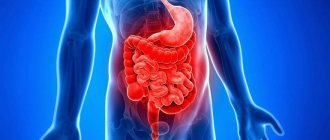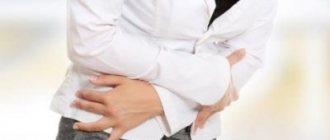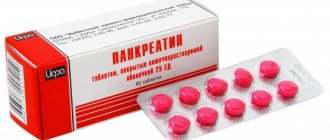The digestive system quickly reacts to any adverse changes. Stomach problems, be it gastritis, bulbitis or even simple heartburn, need to be eliminated in the early stages. No matter how unpleasant the gastroscopy procedure may seem, it is necessary.
Catarrhal esophagitis is an unpleasant and in some cases dangerous disease of the esophagus. Its symptoms cannot always be recognized in time to begin treatment, and then the disease can take a chronic form.
Leakage
Esophagitis
The disease is characterized by inflammation of the esophageal mucosa. As a result, the person experiences severe discomfort, pain and a sensation as if there is a lump in the throat.
The inflammatory process can have different locations, covering the entire esophagus or only the end adjacent to the stomach. This is revealed by gastroscopy. The second case entered medicine as distal esophagitis.
Often the patient assumes that he has gastritis and begins to self-medicate (including folk remedies), which is not possible. Gastritis and esophagitis are different diseases and require different treatment. Gastritis is often the cause of inflammation of the esophageal mucosa. In any case, gastroscopy is inevitable.
Forms
Reflux esophagitis
Acute form. Develops in the event of a single exposure to an aggressive factor. This could be hot or spicy food, or poorly chewed food. The cause is often a phenomenon called reflux - the release of acidic stomach contents. As a result, the disease can develop into a chronic one.
Chronic form. Develops due to constant exposure to the mucous membrane. In this case, treatment is necessary. You should not rely on other people’s advice on treatment with folk remedies, otherwise complications are possible, including esophageal cancer.
Bulbitis and esophagitis
This is what bulbit looks like
Bulbitis, an inflammation of the duodenal bulb, also has similar symptoms. Bulbitis can begin due to similar exposure factors (infection, heavy food), but some symptoms differ.
The main difference that distinguishes bulbitis is the bitterness in the mouth and when vomiting, as well as severe headaches. Painful sensations radiate to the navel area. Bulbitis can be diagnosed by gastroscopy.
It is impossible to treat bulbitis, just like catarrhal esophagitis. A diet and a course of medication are required, which may be accompanied by folk remedies approved by a doctor.
Causes of catarrhal distal esophagitis
- Superficial thermal burn caused by swallowing hot food;
- Exposure to the mucous membrane of chemicals;
- Inadequacy of the sphincter, which allows acidic gastric juice to pass through.
Catarrhal inflammation of the organ is sometimes acute. In this case, no signs of intoxication are observed. If the necessary treatment is not available, this stage becomes chronic, and its symptoms become more and more complex:
- Heartburn and chest pain, which occur immediately after eating, are the main symptom of distal catarrhal esophagitis;
- Belching air;
- Reflex vomiting;
- Sour taste in the mouth.
To confirm this diagnosis and prescribe treatment, doctors use gastroesophagoscopy. The mechanism of the healing procedure for distal catarrhal esophagitis is similar to the treatment of grade 1 reflux esophagitis.
Cardia insufficiency is a disease manifested by symptoms in the form of partial closure of the valve between the esophagus and the inside of the stomach. The result of the disease is the reflux of stomach contents into the esophagus, which is fraught with erosive damage and malignancy of the esophageal epithelium.
The main prerequisites for cardia failure in distal esophagitis are:
- Disturbed diet and bad habit of eating at night;
- Excess weight;
- Chronic stomach diseases and tumors;
- Decreased immunity and weakness;
- 1st degree pyloric spasm and high pressure in the peritoneum.
As a result of these factors, chronic cardia failure occurs, which can lead to many complications. That is why, at the first symptoms, immediately contact a specialist. Adequately prescribed treatment can prevent the development of distal erosive esophagitis.
Typically, the disease develops in three stages:
- The 1st degree of cardia insufficiency is characterized by incomplete closure and the occurrence of air belching;
- At grade 2, prolapse of the gastric mucosa occurs, which is fraught with obstruction;
- Stage 3 is characterized by complete gaping of the sphincter and preservation of intestinal motility.
Causes and signs of erosive distal esophagitis
The main prerequisite for the occurrence of superficial distal and erosive esophagitis is considered to be the reflux of acidic contents into the esophagus. The causes of reflux are valve weakness and overcrowding of the stomach. The mucous membrane has no protection from gastric juice, so it quickly becomes inflamed. It is for this reason that doctors prescribe a diet to patients.
Erosive distal esophagitis forms after acute or chronic damage to the esophagus. The disease often occurs due to chemical burns and severe bacterial infections of a superficial nature.
The erosive form of esophagitis makes itself felt by pain in the esophagus, burning in the sternum, belching with blood and heartburn. After blood loss, anemia and weakness are observed.
How is erosive distal esophagitis treated?
During the treatment of any chronic form of esophagitis (distal, catarrhal, erosive), doctors recommend following a gentle diet with limited smoking and alcohol intake. Healing will be promoted by a diet of cooked and soft foods, as well as the use of H+ blockers, antacids and alginates. It is also recommended to take enveloping and anti-inflammatory drugs for superficial chronic esophagitis. To prevent relapse in catarrhal, distal, erosive forms, specialists prescribe a course of treatment with special drugs for the stomach.
Even after completing treatment for any form of the disease, it is necessary to follow a diet and avoid stressful situations.
Features of the diet for distal esophagitis
Meals must be fractional, so with catarrhal and distal esophagitis you should eat up to six times a day. Treatment with proper nutrition suggests that you can no longer eat anything about four hours before bedtime.
In addition, it is necessary to remember that it is not recommended to lie down immediately after eating, so as not to provoke an exacerbation. When treating catarrhal and other forms of stage 1 disease with correct nutrition, you should strictly follow the specialist’s recommendations and strictly follow them all. At the same time, you should not overeat and eat foods that cause bloating (fresh bread, cabbage, chocolate, carbonated drinks and hot seasonings).
Damage to the esophageal mucosa in its lower section is rarely isolated. As a rule, the gastric mucosa is first affected (this is manifested by diseases such as gastric ulcer and erosive gastritis), and then the process spreads upward. How does inflammation of the mucous membrane of the esophagus occur in its lower third?
First of all, you should adhere to medical terminology: a condition in which there is inflammation of the esophageal mucosa is called esophagitis. It always starts from the inside - as a reaction to the passage of a bolus of food containing certain irritating substances or liquids, for example, alcohol.
If the cause of inflammation of the esophagus is a pathological condition of the mucous membrane of the upper stomach, then the process spreads above the esophageal sphincter, and the disease is called “distal esophagitis.” The word “distal” means “distant” and means that the pathological process exists at the end of the esophagus farthest from the bolus’ journey.
Reasons for development
There are many reasons for problems with the esophagus. In addition to improper nutrition (spicy, fatty, poor-quality food), in general, they are all divided into two types: physiological and mechanical.
Physiological:
Causes of esophagitisInsufficiency of the gastric cardia (valve that closes the entrance to the stomach after eating).
- Stenosis (that is, narrowing of the esophagus). As a result, food stagnates and pain begins. There is a feeling as if there is a lump stuck in the throat.
- Infectious diseases of the gastrointestinal tract, gastritis.
- Reflux.
- Pregnancy.
- Excess weight.
Mechanical:
- Physical activity immediately after eating.
- A foreign object swallowed and remaining in the esophagus (for example, a fish bone).
Symptoms may develop when harsh chemicals or drugs enter the esophagus.
Signs of catarrhal esophagitis in acute and moderate form
Acute esophagitis is characterized by a pronounced course. The following signs of catarrhal esophagitis in its acute form are known:
- discomfort when swallowing food;
- burning pain in the esophagus, increasing as food moves through it;
- neck pain;
- heartburn with sour, unpleasant belching;
- white coating on the surface of the tongue;
- excessive salivation;
- fever, chills, malaise.
The acute form of the disease can be complicated by abscesses, perforation of the esophagus, purulent mediastinitis, esophageal stricture, and focal dysplasia.
In gastroenterology, specialists use the term “moderate catarrhal esophagitis” to designate the form of this inflammatory process, which is relatively considered normal and does not belong to the pathologies. As a rule, with such an inflammatory process, gentle nutrition is prescribed for 2-3 days, after which, in most cases, impaired digestive functions are restored without taking medications.
Symptoms
Sometimes catarrhal esophagitis does not manifest itself for a significant period of time. Already when a significant lesion develops, symptoms begin to appear.
Esophagitis is characterized by aching pain in the abdomen and sternum. They occur during meals or immediately after eating. Pain may be accompanied by the following symptoms:
- A burning sensation in the sternum area, heartburn, a feeling of rawness in the throat.
- Chest pain.
- Salivation that occurs in response to reflux.
- Sour belching.
- Nausea, lump in throat.
Distal esophagitis during gastroscopy is characterized by changes in the mucosa: usually soft pink, it becomes scarlet. Hyperemia (inflammation) of tissues and increased vascular pattern are noticeable.
Erosive type
Erosive esophagitis. Constant exposure to the irritant and lack of treatment leads to the development of an erosive form. The cause is often regular reflux, as a result of which the mucous membrane is damaged. Erosion can lead to bleeding and the development of a malignant tumor.
Hemorrhagic esophagitis. This form of the disease often develops with infectious or viral lesions of the gastrointestinal tract. Its main manifestation is hemorrhage into the walls of the esophagus. During gastroscopy, bloody ulcers are observed. The inflammation is much stronger, up to the detachment of the mucous membrane. A lump of exfoliated tissue comes out along with bloody vomit.
Catarrhal reflux esophagitis: what is it, what are the symptoms and how to treat
Not everyone knows what it is - catarrhal reflux esophagitis - and how it differs from ordinary esophagitis. It represents one of the varieties of this pathological process. Its development occurs as a result of regular reflux of gastric or intestinal contents back into the esophagus. In a healthy person, in the absence of disturbances and abnormalities in the functioning of the digestive system, the esophagus has an alkaline environment, and the contents of the stomach have an acidic environment, which has a detrimental effect on the upper gastrointestinal tract.
The patient is concerned about the following symptoms with catarrhal reflux esophagitis:
- indigestion;
- chest pain;
- heartburn.
As a result of regular spontaneous reflux of stomach or intestinal contents into the esophagus, its lower section is inevitably damaged. This process is accompanied by characteristic symptoms in the form of pain and heartburn. Another symptom that allows you to recognize the development of a digestive disorder is sour belching, attacks of nausea and vomiting. The characteristic symptoms of the disease make it possible to understand what catarrhal esophagitis is and how to treat it at different stages of development.
Diagnostics
Performing gastroscopy
The appearance of the first symptoms is a sign that it is time to see a doctor. He finds out from the patient all the details of the manifestation of the disease, characteristic symptoms and identifies possible causes for their further elimination.
It is determined whether reflux, cardiac insufficiency and other pathologies are present. The condition of the esophagus is assessed using gastroscopy and x-rays. This allows you to clarify the diagnosis and find out whether gastritis or bulbitis is present.
Based on the extensive data obtained, the specialist makes a diagnosis and prescribes treatment.
Types, degrees
Distal esophagitis can be characterized by morphological damage to the esophageal mucosa of varying severity. According to this criterion, the following types of illness are distinguished:
Esophagitis can progress to the point of death of esophageal cells.
- Catarrhal or superficial - without morphological changes in the tissues of the organ.
- Edema - with severe hyperemia and swelling of the mucous membrane.
- Erosive - with the appearance of red focal wounds on the walls. Develops as a result of infection with pathogenic microorganisms and certain irritating substances. If fibrin formation is added to erosions, fibrinous esophagitis develops.
- Hemorrhagic - with large-scale damage to the lining of the esophagus by hemorrhages. Occurs when the body is infected with viruses, for example, influenza, typhus.
- Pseudomembranous and exfoliative - the result of diphtheria or scarlet fever.
- Necrotic - with tissue death. Occurs during the complicated course of infectious diseases.
- Phlegmonous - with mechanical damage to the mucous and submucosal layers.
- Allergic GERD, which occurs with asthma and other respiratory tract lesions.
- Occupational GERD, which appears when workers in production exhale vapors of harmful substances (acids, alkalis, organics).
Rare types of the disease include dysmetabolic and granulomatous esophagitis.
More often, distal reflux esophagitis develops with repeated cycles of cardia insufficiency and appears against the background of exposure to acidic contents from the stomach on the esophagus. According to the nature of the lesions, this disease can be:
- superficial, non-erosive;
- ulcerative with foci of necrosis throughout the entire thickness of the mucosa;
- with damage to the submucosal layers to deep defects, causing thinning of tissues and perforation of the esophageal wall with bleeding.
According to the severity of morphological changes, distal reflux esophagitis develops with the following degrees of severity:
- 1st degree - mild focal redness of the mucous membrane. The structure of the mucosa at the junction with the stomach is loose, with smoothed folds.
- 2nd - single or multiple erosions of an elongated shape with the possible formation of exudate. Wounds appear predominantly in the folds of the mucosa and affect no more than 10% of the entire distal esophagus.
- 3rd - numerous merged erosions, covered with exudate and necrotic tissue. The affected area is more than 50%.
- 4th - merged erosions are located in a circle, severe exudative-necrotic damage is noted. Severe fibrinous lesion covers the entire area 5 cm above the cardia.
Treatment
Distal esophagitis must be treated comprehensively, taking into account the severity of the disease. Treatment of the disease begins with determining a diet and a number of medications. It is also advised to accompany the course with proven folk remedies.
Diet
Diet for esophagitis
Diet for esophagitis involves:
- Eating in small portions, five to six times a day.
- Fried, spicy, salty, sour and fatty foods that adversely affect the condition of the inflamed mucosa are completely excluded.
- Alcohol, soda, coffee and strong tea are also excluded.
If the diet is carefully followed throughout the course, the treatment will be much more effective.
Medicines
A well-designed diet will improve the condition of the esophagus, but it will not be possible to do without medications. Treatment can begin only after a thorough examination and identification of the mechanism of the disease.
Typically, distal esophagitis is treated with several types of medications.
Drugs for the treatment of esophagitis
- If inflammation is caused by reflux, antacids are prescribed: Rennie, Almagel or Malox.
- Alginates are drugs that prevent the reflux of gastric contents. They are also necessary when reflux is diagnosed. An example is Gaviscon.
- Painful sensations are relieved with antispasmodics. But if there is cardiac insufficiency, such drugs are contraindicated.
- Drugs that help improve the motor function of the gastrointestinal tract. This is Motilium, Cerucal. With their use, the lump in the throat goes away; help if there is weak motor activity of the cardia.
- If the cause of inflammation is gastritis or a gastrointestinal infection, treatment is prescribed to eliminate the disease. These can be antibiotics, antimicrobials and enzyme preparations.
Diet and medications can be accompanied by a vitamin course to strengthen the immune system and improve body tone. Distal esophagitis can also be cured with folk remedies, which are used in combination.
Folk remedies
Typically, folk remedies are herbal infusions.
chamomile infusion
Decoctions of chamomile and calendula have an anti-inflammatory effect, soothe irritation, and eliminate it in the throat. A decoction of flax seed has an enveloping effect. It relieves symptoms such as lump in the throat, heartburn. It is also useful to use sea buckthorn oil and oak bark decoction in the treatment of esophagitis.
As you can see, complex treatment of catarrhal esophagitis includes three main components: diet, a course of medications and exposure to folk remedies. Such a trio can quickly cope with damage to the esophageal mucosa and return it to normal.
Share with your friends:
Description
Catarrhal reflux esophagitis differs in that the surface cells of the mucous membrane of the esophagus become inflamed. Deeper tissues are not affected. If the patient immediately begins treatment for the disease, it will have a favorable outcome. If the patient practices self-medication, taking any medications uncontrollably, he may develop erosive esophagitis.
How do the manifestations of catarrhal reflux esophagitis differ and what is it? Under the influence of unfavorable factors (most often irritation of the mucous membrane), damage to epithelial cells occurs. To restore them, the body mobilizes its forces to increase the activity of leukocytes. If they accumulate in one place, then infiltration can be observed.
The activity of leukocytes leads to the release of mediators of the inflammatory process at the site of their accumulation. This increases the permeability of the vascular walls. Inflammation develops, and under the influence of prostaglandins, a person also feels pain.
The disease of any severity develops most often in the male half of the population due to the tendency to smoke and drink alcoholic beverages.
There are the following degrees of the disease:
- 1st degree - the appearance of minor localized lesions;
- 2 degrees - the presence of small areas of inflammation that gradually merge;
- 3 degrees - inflammation of a significant part of the esophageal mucosa;
- 4 degrees - damage to more than ¾ of the organ. Signs of chronic ulcers and esophageal stricture appear against the background of an extensive disease process.










